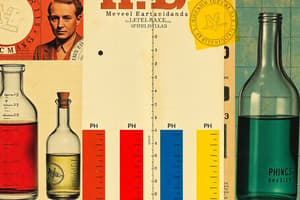Podcast
Questions and Answers
What is the purpose of using indicators in chemistry experiments?
What is the purpose of using indicators in chemistry experiments?
- To speed up the chemical reactions
- To make the experiments more visually appealing
- To identify the presence of acids or bases (correct)
- To enhance the color of the solutions
Which of the following is a natural indicator mentioned in the text?
Which of the following is a natural indicator mentioned in the text?
- Phenolphthalein
- Litmus (correct)
- Methyl orange
- pH paper
Why is it important to understand indicators before conducting experiments with acids and bases?
Why is it important to understand indicators before conducting experiments with acids and bases?
- To prevent the solutions from evaporating
- To avoid misinterpreting the experimental results (correct)
- To ensure safety during the experiments
- To speed up the reaction process
Which statement about acids is not true based on the text?
Which statement about acids is not true based on the text?
How do bases react with indicators?
How do bases react with indicators?
What is the definition of an acid based on the information provided?
What is the definition of an acid based on the information provided?
What are some examples of natural indicators discussed in the text?
What are some examples of natural indicators discussed in the text?
Give examples of strong acids based on the text.
Give examples of strong acids based on the text.
What are some examples of bases mentioned in the text?
What are some examples of bases mentioned in the text?
What color change do acids cause in litmus paper?
What color change do acids cause in litmus paper?
What happens to the smell of onion when diluted acid is added?
What happens to the smell of onion when diluted acid is added?
Why does adding acid to a mahal not bring any change according to the text?
Why does adding acid to a mahal not bring any change according to the text?
Flashcards are hidden until you start studying
Study Notes
- The speaker welcomes everyone back after a break and expresses missing the students.
- They mention teaching chapters like Life Processes, Chemical Reactions, and Acids, Bases, and Salts.
- Differentiates between natural indicators like litmus and artificial indicators like phenolphthalein.
- Discusses how indicators change color in the presence of acids or bases.
- Explains the process of identifying acids and bases using indicators like litmus paper and pH paper.
- Talks about the color changes that occur when different indicators react with acids or bases.
- Mentions the significance of indicators in chemistry experiments and testing for acidity or basicity.
- Gives examples of natural indicators like turmeric and clove and artificial indicators like methyl orange.
- Emphasizes the importance of understanding indicators before starting experiments involving acids and bases.
- Highlights the visual changes that occur when indicators react with different substances.
- Encourages subscribing to their channel for more educational content on indicators, acids, and bases.- Adding acid to a mahal does not bring any change.
- Strong acids have their own smell.
- Diluted acid in water does not affect the smell of onion.
- Onion smell remains the same even after adding acid.
- Acids can be found in lemon, vinegar, and tamarind.
- Bases can be found in soap and toothpaste.
- Bases react with indicators to change their color.
- Acid is defined as a substance that turns blue litmus paper red.
- Bases are substances that convert blue litmus paper to red.
- Chemical properties of acid and base are demonstrated by conducting experiments.
Studying That Suits You
Use AI to generate personalized quizzes and flashcards to suit your learning preferences.




